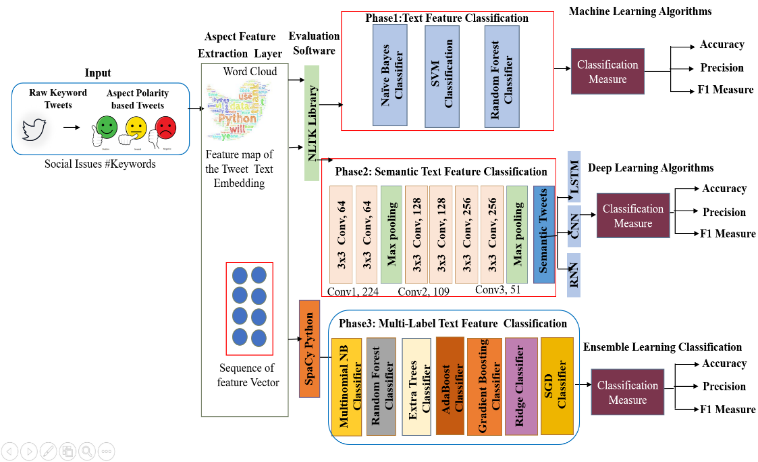Expressivity of Tweets on Social Issues Using Aspect Based Text Classification
Main Article Content
Abstract
Social discussions about crime on Twitter and open forums aims to understand the barriers that hinder people from expressing their concerns or aligning with popular opinions. A curated dataset spanning three months in 2023 was collected, covering categories like crimes and Gender Equality and Violence Against Women.
The study employs aspect-based sentiment analysis to classify sentiment polarity in tweets, utilising a comprehensive framework involving three text feature classification stages. The initial stage analyses individual words, phrases, and tweet patterns to classify text features based on specific linguistic elements. In the subsequent step, semantic relations explore a better understanding of the core sentiment and infer relationships between different text keywords. This stage enhances the analysis by considering the meaning and contextual nuances of the language used in the tweets. The final stage incorporates transformer-based models for effective multilabel classification to view the diversity present in the dataset. The study's quantitative analysis reveals that the Ensemble learning approach demonstrates an impressive precision measure of 93%. By integrating the three stages of text feature classification, the study enhances the accuracy and comprehensiveness of sentiment analysis in social discussions about crime on Twitter.
Article Details
References
Tucker, R. O. (2021). Who ‘Tweets’ Where and When, and How Does it Help Understand Crime Rates at Places? Measuring the Presence of Tourists and Commuters in Ambient Populations. Journal of Quantitative Criminology, 37, 333 - 359. https://doi.org/10.1007/s10940-020-09487-1
Hannach, H. &. (2018). WordNet based Implicit Aspect Sentiment Analysis for Crime Identification from Twitter. International Journal of Advanced Computer Science and Applications., 9. https://doi.org/10.14569/IJACSA.2018.091222
Prathap, M. V. (2023). Crime Analysis and Forecasting Using Twitter Data in the Indian Context. 2023 International Conference on Artificial Intelligence and Smart Communication (AISC) (pp. 919-924). Greater Noida, India. https://doi.org/10.1109/AISC56616.2023.10085282
Benkhalifa, H. E. (2018). WordNet based Implicit Aspect Sentiment Analysis for Crime Identification from Twitter. International Journal of Advanced Computer Science and Applications(IJACSA), 9(12). http://dx.doi.org/10.14569/IJACSA.2018.091222
Sangeeta Lal, L. T. (2020). Analysis and Classification of Crime Tweets. Procedia Computer Science,, 167, 1911-1919. https://doi.org/1016/j.procs.2020.03.211
Rao, L. (2022). Sentiment Analysis of English Text with Multilevel Features. Scientific Programming. https://doi.org/10.1155/2022/7605125
Kulkarni, V. L. (2022, May 03). CTM - A Model for Large-Scale Multi-View Tweet Topic Classification. North American Chapter of the Association for Computational Linguistics. https://aclanthology.org/2022.naacl-industry.28.pdf
P. Vyas, M. R. (2022, June ). Automated Classification of Societal Sentiments on Twitter With Machine Learning. IEEE Transactions on Technology and Society., 3(2), 100-110. https://doi.org/10.1109/TTS.2021.3108963
Fitri Andri Astuti, B. P. (2022). Antisocial Behavior Monitoring Services of Indonesian Public Twitter Using Machine Learning. Proceedings of 2021 International Conference on Data Science and Official Statistics (ICDSOS), Vol. 2021. https://doi.org/10.34123/icdsos.v2021i1.181
Bouadjenek MR, S. S. (2022). A longitudinal study of topic classification on Twitter. PeerJ Computer Science., 8. https://doi.org/10.7717/peerj-cs.991
Ellsberg, M. (2006). Violence against women and the Millennium. International Federation of Gynecology and Obstetrics, 94, 325—332. https://doi.org/10.1016/j.ijgo.2006.04.021
Babu BV, K. Y. (2017). Violence against Women and Girls in the Sustainable Development Goals. Health Promotion Perspectives, 7(1), 1-3. https://doi.org/10.15171/hpp.2017.01
Gu, X. &. (2022). Research on gender prediction based on short texts on Chinese social platforms. 2022 2nd International Conference on Consumer Electronics and Computer Engineering (ICCECE).
Brooks, R. C.-B. (2022). Incel Activity on Social Media Linked to Local Mating Ecology. Psychological Science, 33(2), 249–258. https://doi.org/10.1177/09567976211036065
Ismet, H. M. (2022). Aspect Based Sentiment Analysis of Product Review Using Memory Network. Scientific Journal of Informatics., 9(1). https://doi.org/10.15294/sji.v9i1.34094
Trang Uyen Tran, H. T. (2022). Toward a multitask aspect-based sentiment analysis model using deep learning. IAES International Journal of Artificial Intelligence (IJ-AI), 11 ((2)), 9. https://doi.org/10.11591/ijai.v11.i2.pp516-524
Ray, P. A. (2022). A Mixed approach of Deep Learning method and Rule-Based method to improve Aspect Level Sentiment Analysis. Applied Computing and Informatics, 18, 163-178. https://doi.org/10.1016/j.aci.2019.02.002
Rezaeenour, J. A. (2023). Systematic review of content analysis algorithms based on deep neural networks. Multimed Tools Appl, 82, 17879–17903. https://doi.org/10.1007/s11042-022-14043-z
Rahman M, I. D. (2020). A deep learning approach based on convolutional LSTM for detecting diabetes. Comput Biol Chem. https://doi.org/10.1016/j.compbiolchem.2020.107329
Grootendorst, M. (2022). BERTopic: Neural topic modelling with a class-based TF-IDF procedure. arXiv:2203.05794.
Martoglia, R. &. (2022). A Predictive Method to Improve the Effectiveness of Twitter Communication in a Cultural Heritage Scenario. ACM Journal on Computing and Cultural Heritage (JOCCH), 15. https://doi.org/10.1145/3470786
Hourrane, O. &. (2022). Topic-Transformer for Document-Level Language Understanding. Journal of Computer Science., 18(1). https://doi.org/10.3844/jcssp.2022.18.25
Bozarth, L. &. (2022). Keyword expansion techniques for mining social movement data on social media. EPJ Data Science., 11. https://doi.org/10.1140/epjds/s13688-022-00343-9
Kaur, G. S. (2023). A deep learning-based model using hybrid feature extraction approach for consumer sentiment analysis. J Big Data, 10(5). https://doi.org/10.1186/s40537-022-00680-6
Kunapuli, G. (2023 ). Ensemble Methods for Machine Learning. (9781617297137, Ed.)
Zhang, R. (2022). Research on Social Media Feature Learning Algorithm Based on Deep Neural Network. IEEE 2nd International Conference on Power, Electronics and Computer Applications (ICPECA), (pp. 590-594). Shenyang, China. IEEE. https://doi.org/10.1109/ICPECA53709.2022.9719080
Li Xiaoyan, R. C. (2022). GloVe-CNN-BiLSTM Model for Sentiment Analysis on Text Reviews. Journal of Sensors, 12. https://doi.org/10.1155/2022/7212366
Liang, Y. L. (2021). Fusion of heterogeneous attention mechanisms in multi-view convolutional neural network for text classification. Information Sciences, 548, 295-312. https://doi.org/10.1016/j.ins.2020.10.021
Dimosthenis Antypas, A. P.-C. (2023). Negativity spreads faster: A large-scale multilingual Twitter analysis on the role of sentiment in political communication. Online Social Networks and Media, 33. https://doi.org/10.1016/j.osnem.2023.100242.
Xu, S. &. (2023). CNN-VAE: An intelligent text representation algorithm. The Journal of Supercomputing, 1-26. https://doi.org/10.1007/s11227-023-05139-w.
Ghazi Felhi, J. L. (2021). Challenging the Semi-Supervised VAE Framework for Text Classification.https://doi.org/10.48550/arXiv.2109.12969
Ahmad S, A. M. (2019). Detection and classification of social media based extremist affiliations using sentiment analysis techniques. Hum Cent Comput Inf Sci, 9(24). https://doi.org/10.1186/s13673-019-0185-6

